By Allyn Vannoy
“As a returning flight of Marine SBDs, dive bombers, were setting down on the airstrip, one of the planes lost a bomb which had failed to release during the mission. The bomb skidded down the runway and came to a stop in the middle of the field. No one knew if the bomb was armed. Everyone was ducking for cover. Where it lay it was preventing other planes from landing. So, Al Tierny, from St. Paul, Minnesota, and I volunteered to go out and get the bomb off the runway. We jumped in a small truck with a hoist and went out and hooked the bomb up, lifted it off the ground, and got it off to the end of the airstrip, permitting the waiting aircraft to land.” So reported Lance Corporal Robert Vannoy, who was not only an aircraft armorer, but also held a marksman’s badge.
According to my father, Lance Corporal Robert Vannoy, this was part of “life” on a Marine airstrip in the South Pacific.
The entry of the United States into World War II saw a rapid expansion of the Marine Corps’ air arm, reaching a peak by 1945 of five air wings, 31 groups, and 145 squadrons, with just over 100,000 personnel.
For the first two years of the war, Marine air spent most of its time protecting the fleet and land-based installations from attacks by enemy ships and aircraft. This began to change after the Battle of Tarawa in late November 1943, as air support for ground troops as flown by Navy pilots was found wanting. After the battle, Marine General Holland M. “Howling Mad” Smith recommended that “Marine aviators, thoroughly schooled in the principles of direct air support,” take over the job.
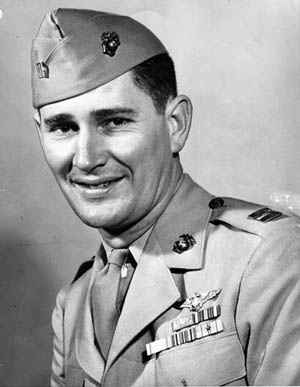
One of the squadrons, Marine Fighter Squadron 115 (VMF-115), officially became part of Marine Fleet Air on July 1, 1943, at Marine Corps Air Station (MCAS), Santa Barbara, California. Its commanding officer, Major Joseph J. Foss, took charge of the unit on July 17. Foss was already a legend as the Marine Corps’ leading ace and a recipient in May 1943 of the Medal of Honor (in late 1942 and early 1943, he shot down 26 Japanese planes in 44 days).
One can only imagine what it felt like for the members of the squadron—both pilots and ground personnel. It must have been an amazing experience for a bunch of young men to come together at such a time and place. In the summer of 1943, optimism was in the air as the war in the Pacific seemed to be in the process of turning in the United States’ favor—even though there was still a great deal of fighting ahead. Santa Barbara, northwest of Los Angeles, was (and is) a fantastic setting. Add to this an amazing new aircraft, the F4U Corsair, and a commander who was already a national celebrity (Foss’s picture appeared on the June 7, 1943, cover of Life magazine; he had just returned from fighting at Guadalcanal, where he became the first American pilot to duplicate Eddie Rickenbacker’s number of kills in World War I). How could these Marines not have wanted to excel in their new roles?
“Joe’s Jokers”
As VMF-115 was starting to get organized, Major Foss was in the process of completing a war bond tour across the United States after being awarded the Medal of Honor. The unit was officially known as the “Silver Eagles,” but he asked the Walt Disney studios to design an “unofficial” insignia for the squadron that would exemplify a more aggressive, devil-may-care attitude. The final insignia was an animated, happy, diving Corsair smoking a cigar––Foss’s trademark––complete with goggles and flowing silk scarf, across a five-card royal flush with a joker and the squadron’s nickname: “Joe’s Jokers.”
The unit received its first F4U Corsairs on July 31, 1943, replacing several Grumman F4F Wildcats. The Corsair was a magnificent plane, called by some the “most beautiful prop-driven fighter of all time,” that would go on to be one of the top fighter aircraft of the war. It was built around a 2,000 horsepower Pratt & Whitney R-2800 Double Wasp 18-cylinder radial engine with fuel injection, internal supercharger, twin Bosch magnetos, disc brakes, and a master hydraulic system. It had a top speed of 417 miles per hour, a maximum ceiling of 36,000 feet, and it was armed with six .50-caliber machine guns. Deciphering the model number, F4U, F is for fighter, 4 indicates the fourth fighter built for the Navy by the manufacturer, and U designates Chance-Vought, the builder. There was also an FG version made by Goodyear.
Charles Lindberg Flies With the Squadron
But the first new Corsairs off the assembly line had mechanical problems. Their engines tended to cut out above 21,000 feet. After three or four pilot deaths, Foss requested that higher headquarters provide an expert to look into the problem. Two days after he requested assistance, a man arrived whom he had tried to meet years earlier as a boy in Sioux Falls, South Dakota: Charles Augustus Lindbergh. Yes, that Charles Lindbergh.
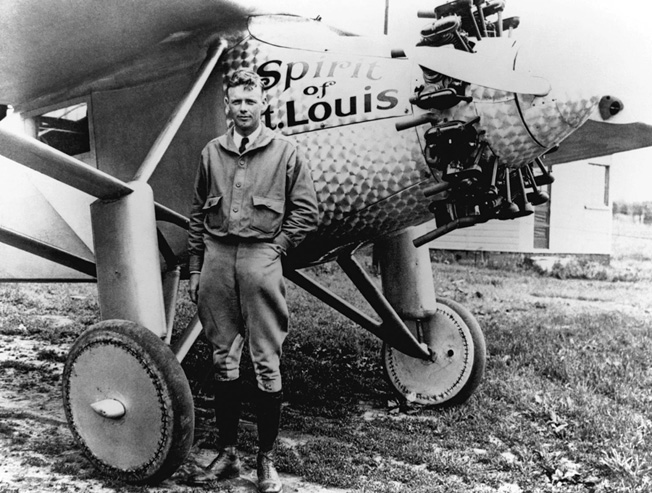
As an aeronautical engineer, Lindbergh was a troubleshooter for military aviation. After working with the squadron for a month, Lindbergh solved the problems with the Corsair and in the process hit it off with the members of the squadron, as well as with Foss, who told him that he was welcome to fly with the squadron any time. (Lindbergh took him up on the offer many times.)
The Men on the Ground
With an authorized strength that included some 40 pilots, the bulk of the unit was in the ground support element, or aircraft maintenance personnel. A member of the maintenance staff, Charlie Romine, described the organization. The squadron’s table of organization for the aircraft maintenance crew called for a leading chief, an MT sergeant (master technical sergeant), as the top NCO, who came under the squadron’s engineering officer. The leading chief’s duties were to coordinate the activities of the line chief and engineering chief. The line chief, also an MT sergeant, supervised all crew chiefs, who conducted preflight inspections, maintained the aircraft, and supervised minor repairs. The engineering chief oversaw periodic engine checks, problem analysis, major repairs, and the general condition of the aircraft. However, operational reality was different from the table of organization as crew talents of the new “Air Marines” developed and functions became smoother. The need for the leading chief to coordinate and provide detailed direction decreased, the unit becoming a close-knit organization.
The squadron underwent a transformation as the group of young men that had been thrown together became a highly efficient organization in a short time. Most of the Marines were just 18, 19, or in their early 20s, but all were Marine volunteers. They were radiomen, mechanics, ordnance technicians, and other specialists—trained, but without practical experience. They quickly realized the importance of their duties and the squadron’s operational mission.
Ground personnel understood that their whole reason for being was to keep the Corsairs in the air and in fighting condition. Therefore, they had a great deal of admiration and respect for the pilots, the men who would be putting their lives on the line every time they went up. The pilots lived in their own world and developed a strong brotherhood, having a special kind of pride, independence, and confidence, which some misread as arrogance.
Foss Readies His Squadron For Combat
Given Foss’s previous overseas experience, he wanted to have the best-equipped squadron possible, and not just in terms of aircraft. The unit also had a portable sawmill, rumored to have been provided by one of Foss’s admirers, along with an ice-cream-making machine and a ton of ice cream mix. Another addition was a machine shop, which was attached to provide a greater degree of self-sufficiency. The machine shop was housed in a large trailer equipped with lathes, a mill, a grinder, welding equipment, and all the appropriate tools and fixtures.
As an added bonus for the squadron, Foss’s newfound fame and Hollywood connections brought a number of entertainers to the base to put on shows for the men. These included comedian Bob Hope, actor Gary Cooper, singer Bing Crosby, and bandleader Kay Kyser.
For the next seven months the squadron trained at Santa Barbara and prepared to go into combat. But “routine” operations resulted in numerous crashes due to pilot error and mechanical failures. The loss of 15 pilots during this time provided a reminder of the cold realities of war.

Foss was given a great deal of freedom in organizing the squadron; he was allowed to choose his own top officers: Greg Loesch, executive officer, a veteran with eight and a half air victories who had been Foss’s second in command in VMF-121; and Big Bill Freeman, engineering officer, with five victories and three engineering degrees—mechanical, electrical, and aeronautical. The three men had served together in VMF-121 during the heady days on Guadalcanal in the fall of 1942. (Loesch was later killed at Santa Barbara when he and his wingman collided in midair. Freeman would later add a sixth kill to his record.) Foss also selected five other veteran officers to be part of the squadron.
Arriving at Emirau
On February 12, 1944, squadron members were ordered to pack their sea bags, combat equipment, and rifles, and were trucked to San Diego. Once there, they boarded the seaplane tender USS Pocomoke (AV-9) for transport to Guadalcanal. The ship weighed anchor the next day.
While en route they stopped at Pearl Harbor, then headed for Espiritu Santo in the New Hebrides, arriving on March 4, with brief stops at British Samoa and the Fiji Islands. Next the ground support personnel were put up in a tent camp next to Henderson Field on Guadalcanal—now a backwater and support base for the fighting taking place farther northwest in the Solomons.
While the squadron was in transit, the senior commanders in the Pacific were planning how and where to use it. Though General Douglas MacArthur, supreme commander of Allied Forces in the Southwest Pacific Area (SWPA), had planned to capture the Japanese base at Kavieng on New Ireland, Admiral William (Bill) Halsey, commander of the South Pacific Area, believed that a bypass operation was in order and that the seizure of a site in the St. Matthias Group would provide a quick and cheap alternative to neutralize Kavieng and complete the isolation of the key Japanese stronghold at Rabaul. Halsey won; the island selected was Emirau, approximately 90 miles northwest of Kavieng.
The island, located approximately one and a half degrees south of the equator, is at the northern end of the Bismarck Archipelago. A coral island with dense vegetation, it had once hosted a leper colony and was populated by snakes, reptiles, and disease-carrying insects. It was also home to a population of tropical bats with wingspans of two to three feet, numerous small lizards, and foot-long praying mantises. Guards who pulled duty at night found a jungle illuminated by the glow of green radiant light produced by mushroom fungus––like a thousand eyes staring back at them.
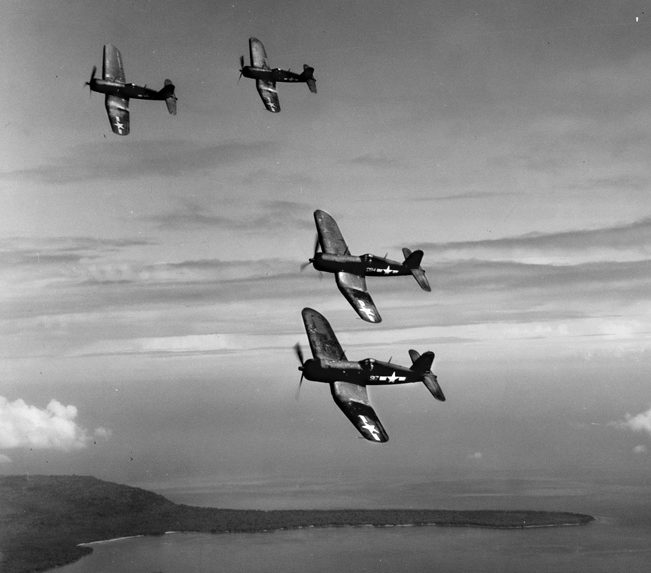
On March 20, 1944, the 4th Marines (formerly the 2nd Marine Raider Battalion) landed unopposed on the island, followed by naval construction battalions (Seabees), who set about building an airstrip. The strip was cut across the island as the trees and topsoil were removed, the coral leveled to a white, flat surface as hard as concrete.
In mid-April, VMF-115’s ground support echelon loaded their equipment on board LST (Landing Ship, Tank)-488, the personnel embarking on a transport, the USS George Clymer (AP-57) from Guadalcanal, and arriving at Emirau on April 20. The pilots reached the island with their aircraft on May 2, having picked up their Corsairs at Espiritu Santo. Unfortunately, during the process, one pilot, 1st Lt. Jack Aldrich, lost his life on takeoff.
Operations With MAG-12
The squadron, now part of Marine Air Group 12 (MAG-12) of the 1st Marine Air Wing, began air operations on May 3. Eventually, other units on the island included Marine dive bombers and torpedo bombers.
With the help of the Seabees, the Marines cleared ground and then constructed what was described as an “impressive” mess hall, an officer’s mess, tents with wood floors and frames for pilot living quarters, and many other amenities in an effort to make life on the island as bearable as possible. Also constructed was an amphitheater using a long hillside from which they removed the trees. A movie projector was placed near the top of the hill, and a screen at the bottom.
The unit, independent and somewhat isolated, was given a certain amount of individual entrepreneurship. It wasn’t long before enterprising individuals developed markets for used jeeps, sidearms, whiskey, souvenirs, and scarce aircraft parts. An assortment of sidearms appeared that included revolvers, German Lugers, and .45-caliber semiautomatics. The Marines also carried sheathed knives, most not being service-issued.
By mid-May, Emirau was a full operating partner in the ring of Allied bases surrounding Rabaul, with the pilots creating havoc over Kavieng and New Britain in an effort to neutralize the Japanese strongholds. Operations were carried out in conjunction with Allied air units on Green Island, Bougainville, and Treasure Island. But by the time the squadron was deployed, the backbone of Japanese aviation had been broken in the South Pacific, and so there were few opportunities for air-to-air combat.
Combat Missions With Lindbergh
Unexpectedly, in May, Charles Lindbergh showed up, cashing in on Foss’s promise to let him fly with the squadron. For the next month he flew missions, searching for ships and attacking ground targets. Flying from morning till night, he taught the Marines tricks that included how to significantly extend their range. Foss remembered Lindbergh as a thorough pilot––not one to take unnecessary risks and never flying without a map. But on one occasion Foss had to take him to task for a solo second pass when making a strafing run on an enemy supply dump with all the anti-aircraft guns in the area concentrating fire on his plane.

The squadron’s missions included escort for SCAT (South Pacific Combat Air Transport) flights, patrol boat cover, dawn and dusk combat air patrols, searching for life rafts or distress signals, strafing Japanese warehouses and barges, airstrip alert for interception of possible “bogies,” “Dumbo” (PBY rescue planes) escort, bomber escort, and reconnaissance. Missions ranged over New Hanover, Byron Strait, Kavieng, Djual Island, Balgai airstrip, New Ireland, and, of course, Rabaul, the main Japanese naval base on New Britain at the northwest end of the Solomon chain.
The Allies were hitting Rabaul at least once, sometimes twice, a day. Foss said, “The battle was fierce, and our losses were heavy among the dive bombers and torpedo planes going into Rabaul because they had to go right down onto the target.”
The first combat casualty of the squadron occurred on May 22, when, during a mission over New Ireland, anti-aircraft fire struck the plane of 1st Lt. Percy M. Hall, Jr., causing it to crash and explode. Two days later the engine of 1st Lt. Kenneth L. Meyer’s plane failed in flight, and he was drowned after crash-landing in the ocean.
Life on Emirau
The daily flight schedule was frenzied, and flying the Corsair in battle was a whole new experience for the veteran pilots, requiring a very different approach from the earlier Grumman F4F Wildcat. Foss said, “I’d lead the squadron in at a high altitude until we were within striking distance of the target. Then the guys would peel off, rolling over onto their backs for power dives at the target below. [Though] dive bombing did not hold the same excitement and challenge that dogfights did, it was no less dangerous. Night attacks were particularly hazardous.”
Life settled into a routine of launching daily combat missions and aircraft maintenance operations. To break the tedium, some of the Air Marines built outrigger canoes from scrap Corsair belly tanks and used Seabee-supplied dynamite to fish the waters around the island.
Despite their creature comforts, the Marines were living on the edge of a rotting, stinking jungle with little opportunity for liberty. Operating near the equator in sweltering heat, the Marines labored under a blazing sun as their daily dress was reduced to cut-off dungarees, open shirts or T-shirts, and baseball caps.
By July 1944, VMF-115 had 49 officers and 249 enlisted men, 15 F4Us, and five FG-1As that were flying thousands of hours and conducting hundreds of missions each month.
On August 10, 1944, Foss, now a lieutenant colonel, left Emirau for Bougainville because of recurring attacks of malaria. He was eventually sent back to the States for treatment. Major John H. King, Jr., the squadron’s executive officer, assumed command on September 21.
On Mission With PT Boats
In an effort to break the monotony of daily base life, and seeking an opportunity to “get into the action,” two young ground crew Marines, John Gunther and Robert Vannoy, found a chance to do more than work on aircraft. A squadron of PT boats was based at Emirau, and Gunther’s brother was a skipper on one of the boats. Unbeknownst to any of VMF-115’s officers, after a day of maintenance work the two Air Marines would go down to the dock area around dusk to join the PT crews that were preparing to head out on their nightly raids, usually along the coast of New Ireland. The crews appreciated the relief––a chance to stay ashore and get some rest. Vannoy said, “Operating the .50-caliber machine guns, we’d shoot up the Japanese barges or shore installations. Also, the boats would transport Australian scouts or coast watchers.”
In addition to air operations, Emirau served as a way station for a small party of Australian soldiers, outstanding jungle fighters with their distinctive “Digger” headgear, who were part of a reconnaissance group. Navy PT boats would drop a squad or scouting party on a beach at night near Kavieng or Rabaul and rendezvous to pick them up later.
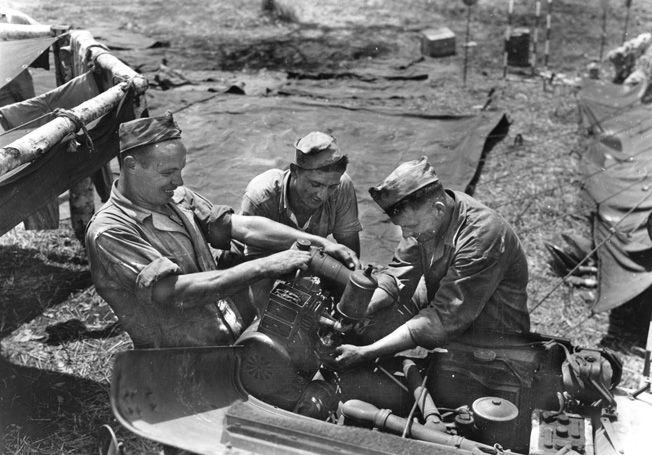
For some time, Marine Maj. Gen. Ralph J. Mitchell, commanding the 1st Marine Air Wing, had been pressing to get the unit a more active role in Pacific operations. On October 20, 1944, Allied landings took place on Leyte Island in the Philippines and the need for increased air support was quickly felt. General MacArthur requested that Marine Air be brought forward to the Philippines to provide additional support for the Army. In late November, the four fighter squadrons of MAG-12 (VMF-115, -211, -218, and -313) were alerted to make ready to move.
Transfer to the Philippines
In early December, the four squadrons moved from Emirau via Hollandia and Peleliu to the Philippines, a distance of 1,957 miles. On the morning of December 3, 66 Corsairs in a series of V formations appeared over Leyte. An advance party of Air Marines on the ground recalled with pride marveling at the magnificent sight as the aircraft approached their new base at Tacloban on Leyte.
The shoreside airfield was overcrowded as aircraft were parked in double rows along both sides of the strip. Right along the water a number of wrecked Navy aircraft littered the edge of the surf—planes from Navy CVEs (small aircraft carriers) that had been sunk during the Battle of Leyte Gulf. Because of the need to keep the strip open, any plane that crashed on landing was simply pushed off the runway and into the surf to make room for others.
The squadron operated from Tacloban for only a short period, but during that time there was considerable activity. The strip was bombed by the Japanese on a fairly regular basis.
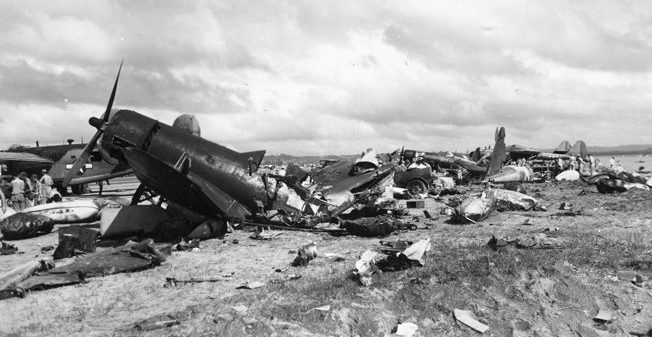
At about dusk one day, an air-raid warning sounded, alerting everyone to the approach of an unidentified aircraft. A Japanese twin-engine transport with wheels and flaps down was preparing to land. Making its turn-in to the landing approach the plane came in over some Navy ships at anchor just offshore, which spotted it, their anti-aircraft guns lighting up the sky. Both sides of the strip were packed wingtip to wingtip with Army, Marine Corps, and Navy fighters. Seeing the plane flying through a hail of fire in flames, personnel along the flight line and working on the parked aircraft dove for cover. The plane was carrying a suicide squad of Japanese soldiers armed with explosives that had intended to land on the field and wreak havoc. Even as the plane was still in the air and on fire, several of them leaped from it, landing among the parked fighters. The transport then exploded in a huge fireball. Two nearby Corsairs, with full gas tanks, detonated in quick succession. Afterward, charred body parts and aircraft debris littered the area. Cleaning up was a gruesome task.
Striking Japanese Shipping
Conditions at Tacloban were primitive. The muddy strip had practically no taxiway. Because of the overcrowding, conducting operations was difficult even in good weather. As a result, several Army and Marine squadrons were moved seven miles away to a field at Tanauan, where an airstrip of Marston mat had been laid over the sand. This reduced the crowding at Tacloban and improved operating efficiency, while also making it a less lucrative target for the Japanese. But, on occasion, the personnel on the ground found themselves ducking for cover whenever a Japanese fighter would slip into the landing pattern among their returning aircraft, usually tailing a group of American planes at about dusk. Some of the Japanese pilots spoke English well enough to fool the control tower into granting landing approval. They would approach the field and then either unload a few bombs or make a strafing sweep through the area.
VMF-115’s missions included bombing attacks on enemy airfields, on Japanese installations at San Isidro Bay, and on enemy convoys, as well as escorting sorties to cover patrol boats, “Dumbos,” supply drops, and flying air cover for Army landings at Ormoc and Mindoro.
During December 1944, the squadron lost 11 aircraft to various causes while being credited with four and a half enemy aircraft destroyed in air-to-air actions.
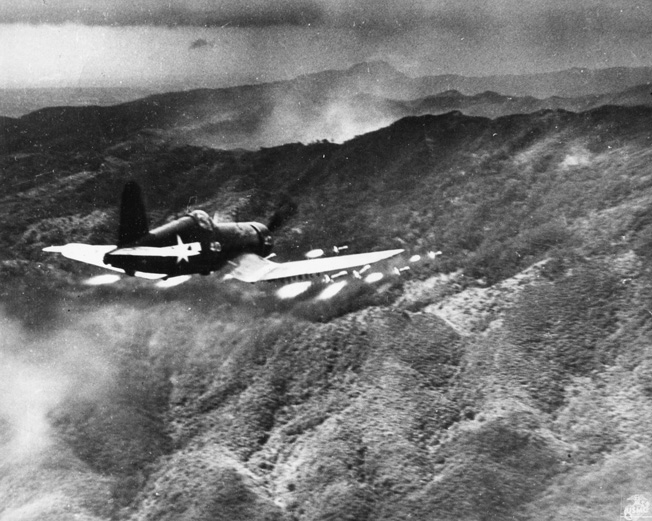
Captain Rolfe F. Blanchard described a joint mission by 30 Army P-40s and 28 F4Us against Japanese shipping: “The Army flight was to strike first, by dive bombing, and we were to follow with a masthead attack … in three waves spaced far enough apart to allow the preceding wave’s bombs to detonate safely. When the ships were sighted, the Army started peeling off in groups of two or three planes and dove from 10,000 to about 5,000 feet, released bombs and pulled back through the overcast. They accomplished nothing except to make interesting splashes in the water and wake up the Japs. AA [anti-aircraft fire] immediately became very intense. As the last Army bombs were falling, our Corsairs were in position and coming in fast and low. The Japs never saw us coming until we started to shoot.”
A total of six hits were scored, sinking two transports and causing slight damage to a destroyer. In a follow-up mission the next day, VMF-115 pilots scored hits on the destroyer Uzuki, sinking her.
“Head Hunting”
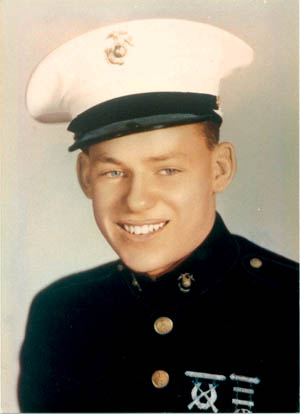
Ground action soon pushed west on Leyte, concentrating in the Ormoc area. As Japanese forces were shattered, they were split into isolated pockets, some melting away into the jungle hills. From the airstrip the Marines could see the campfires of the Japanese who had taken refuge in the hills. Flight operations were also harassed by the occasional sniper.
As part of airfield security, some of the Air Marines participated in operations against the Japanese die-hards, referred to as “head hunting.” Five or six Marines, along with Philippine Army scouts, would go out searching for the Japanese soldiers. Lance Corporal Vannoy said, “I went out about four times. We would take along dynamite to blast them out of the caves, if need be. On one occasion one of them approached us acting as if he wanted to surrender, but he wasn’t showing his hands. We were in a position where we couldn’t back up, so I had to shoot him. We found a couple of grenades hidden on him.”
Landing on Mandanao
As ground combat operations moved across the Philippines, air activity was winding down on Leyte. In late February 1945, the squadron received orders to move to Zamboanga on Mindanao, to an airstrip called San Roque Airfield, in order to support operations on the island.
All the Marines assigned to the Zamboanga invasion force were Marine Air support personnel—basically technicians, but still combat riflemen. LSTs picked up the Marines of MAG-12 at Leyte to transport them to Mindanao.
The Army’s invasion force, supported by cruisers and destroyers, landed near Zamboanga on March 10, the Japanese opposing it with mortars and artillery fire. The next day the advance ground elements of VMF-115 began unloading equipment and personnel from their LSTs on the beach and then moved inland to the nearby airstrip.
The airstrip, once captured, was renamed Moret Field, after Lt. Col. Paul Moret, a Marine aviator killed at New Caledonia in 1943. The Marines secured the area, though their position suffered heavy shelling during the night. The next morning the Air Marines discovered that the Army units in the area had pulled back before the artillery barrage and that the Marines had been the front line during the night.
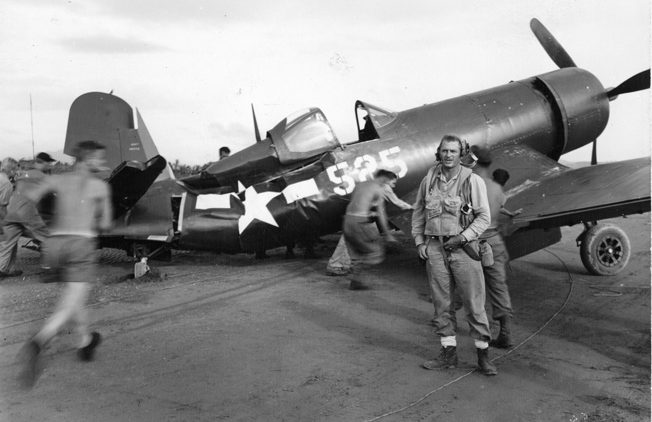
The first planes landed on Moret Field on March 14, 1945. Air strikes were conducted so close to the field that the ground personnel could watch napalm drops from the flight line. The pilots were barely out of the traffic pattern before starting their runs. The field continued to receive shelling, but with little effect. As local hostilities subsided, the Marine Corsairs supported landings on the islands of Sanga Sanga, Bongao, and several others.
The war in the Pacific was winding down.
In the spring and early summer, some members of the ground support element had earned sufficient points to return to the States. Then, following Japan’s surrender, the squadron moved on to northern China in October 1945.
120 Marine Aces in the Pacific Theater
During the course of the war, Marine aviators were credited with shooting down 2,355 Japanese aircraft while losing 573 of their own in combat, producing 120 aces, and earning 11 Medals of Honor. F4Us would claim 2,140 of the shootdowns at the loss of only 189 Corsairs.
For its part, VMF-115 conducted 5,856 combat sorties, shot down six and a half enemy planes, and lost 28 aircraft and nine pilots of its own in operations in the Pacific. For its efforts the squadron earned several honors, including a Presidential Unit Citation and a Navy Unit Commendation. The squadron also received a Philippines Liberation streamer and a Philippine Presidential Unit Citation––a rare achievement among Marine outfits, because few USMC units operated in the Philippines.
Although a fighter squadron, the Air Marines found themselves providing ground support to the Army, conducting operations to isolate and destroy cut-off Japanese garrisons, and occasionally fighting Japanese troops on the ground—with every Marine a rifleman.
In a proud tradition, even today, VMF-115 (now VMFA-115), in a tribute to its original Marine veterans, occasionally goes by the name “Joe’s Jokers.”
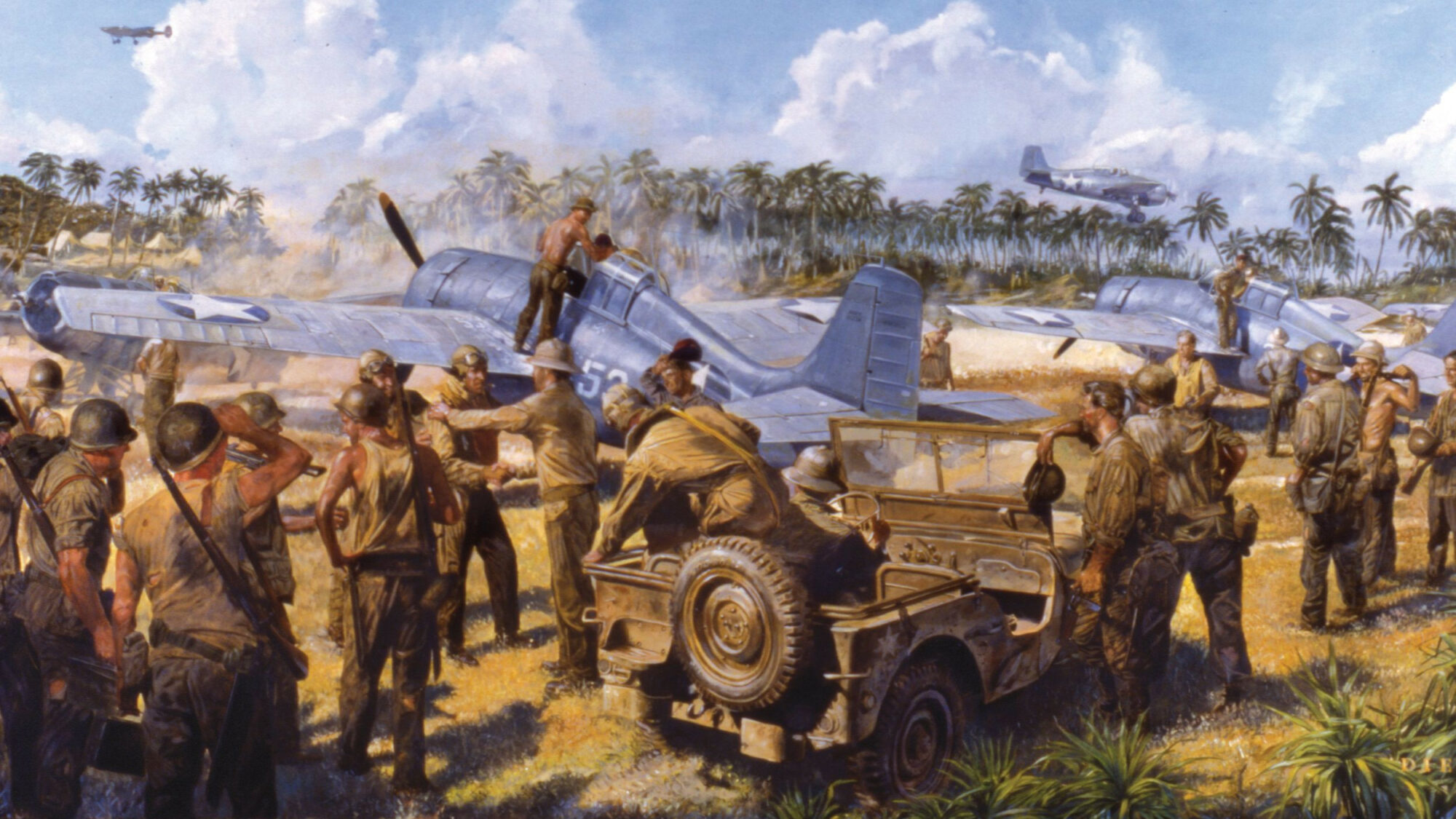


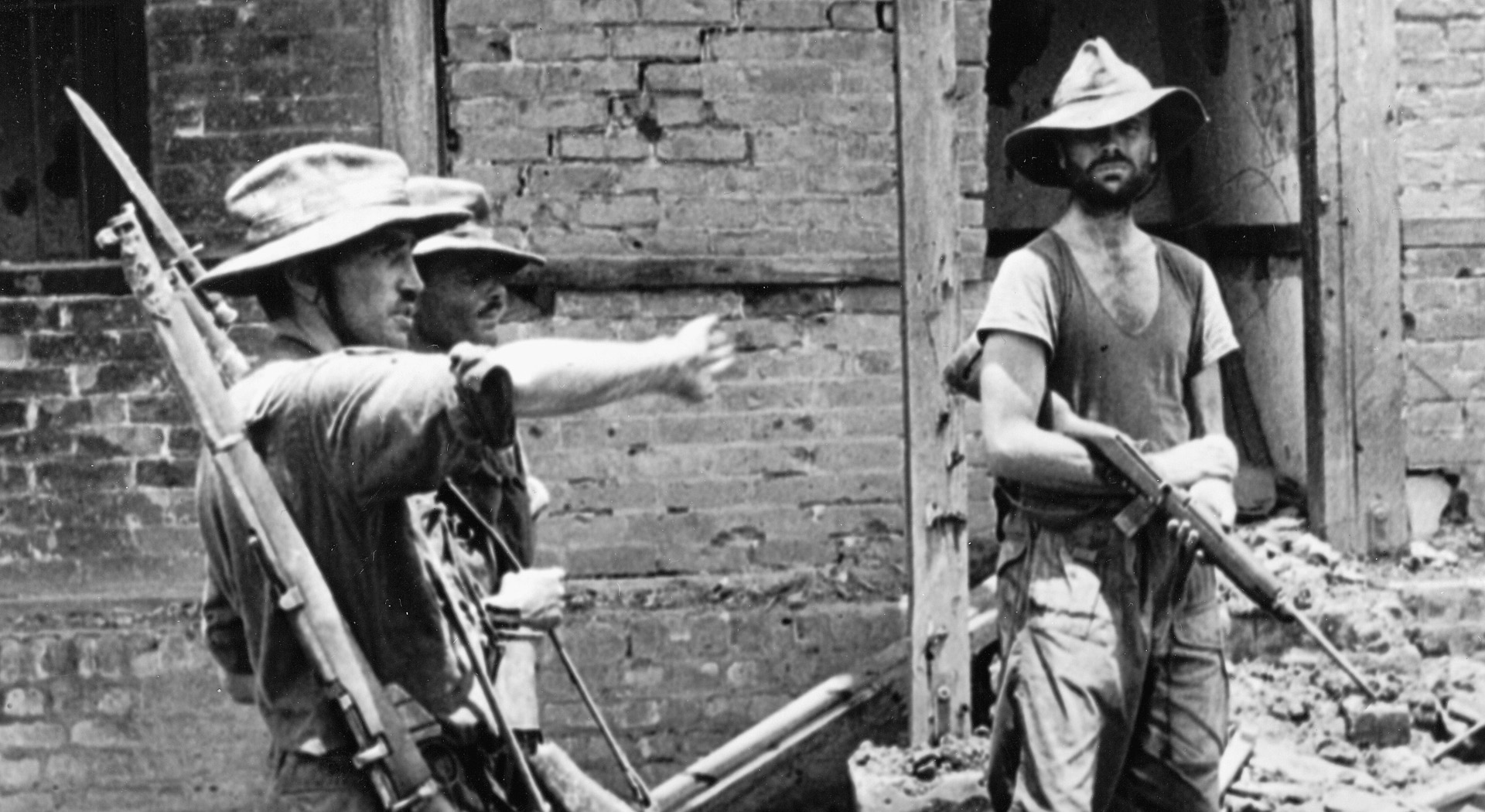
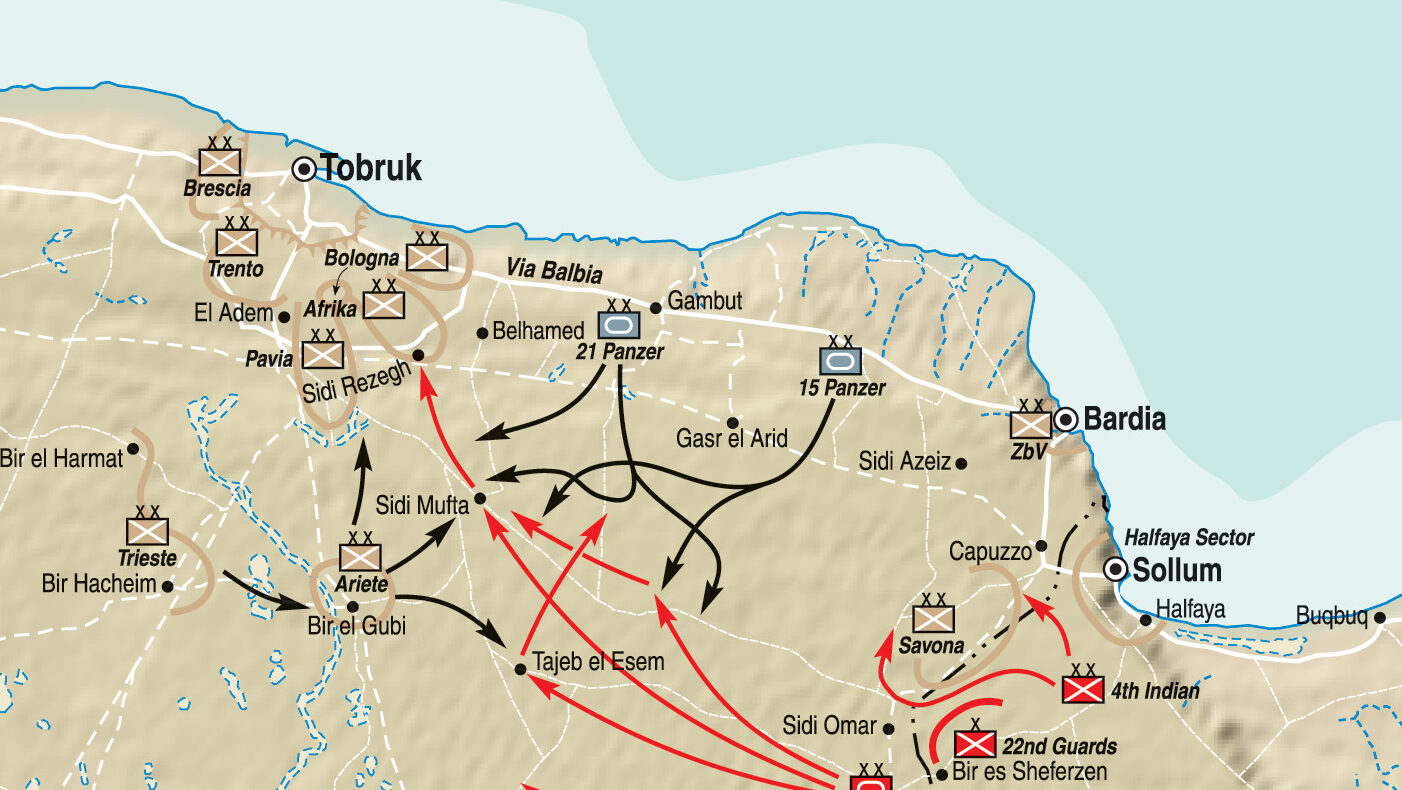
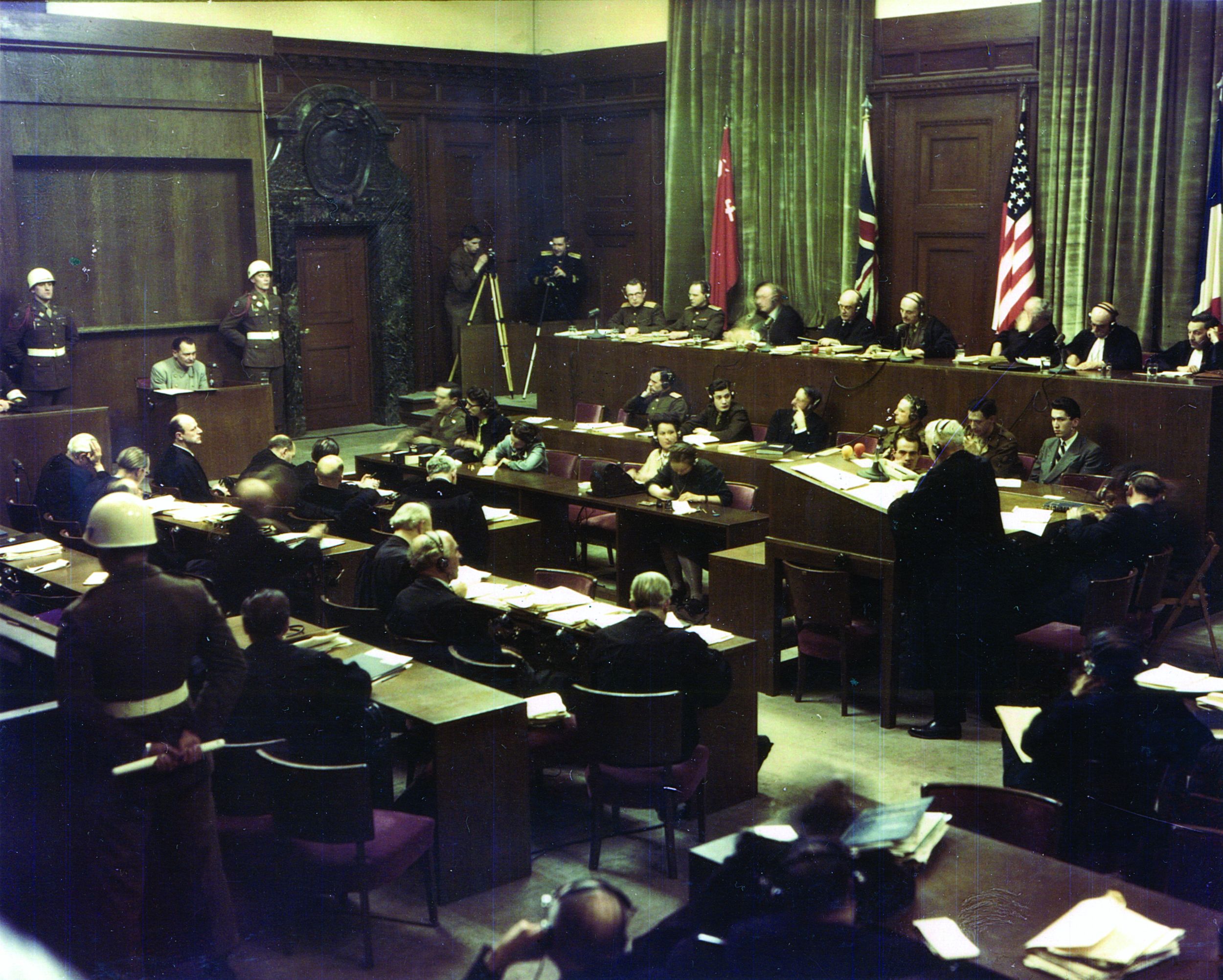
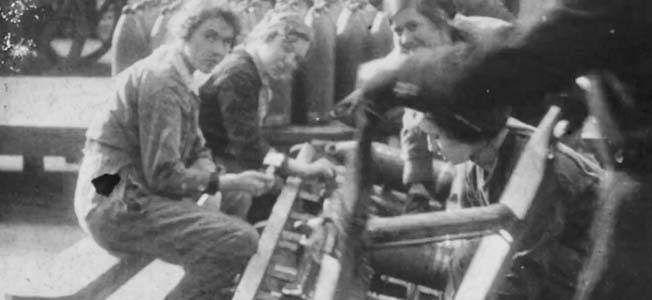
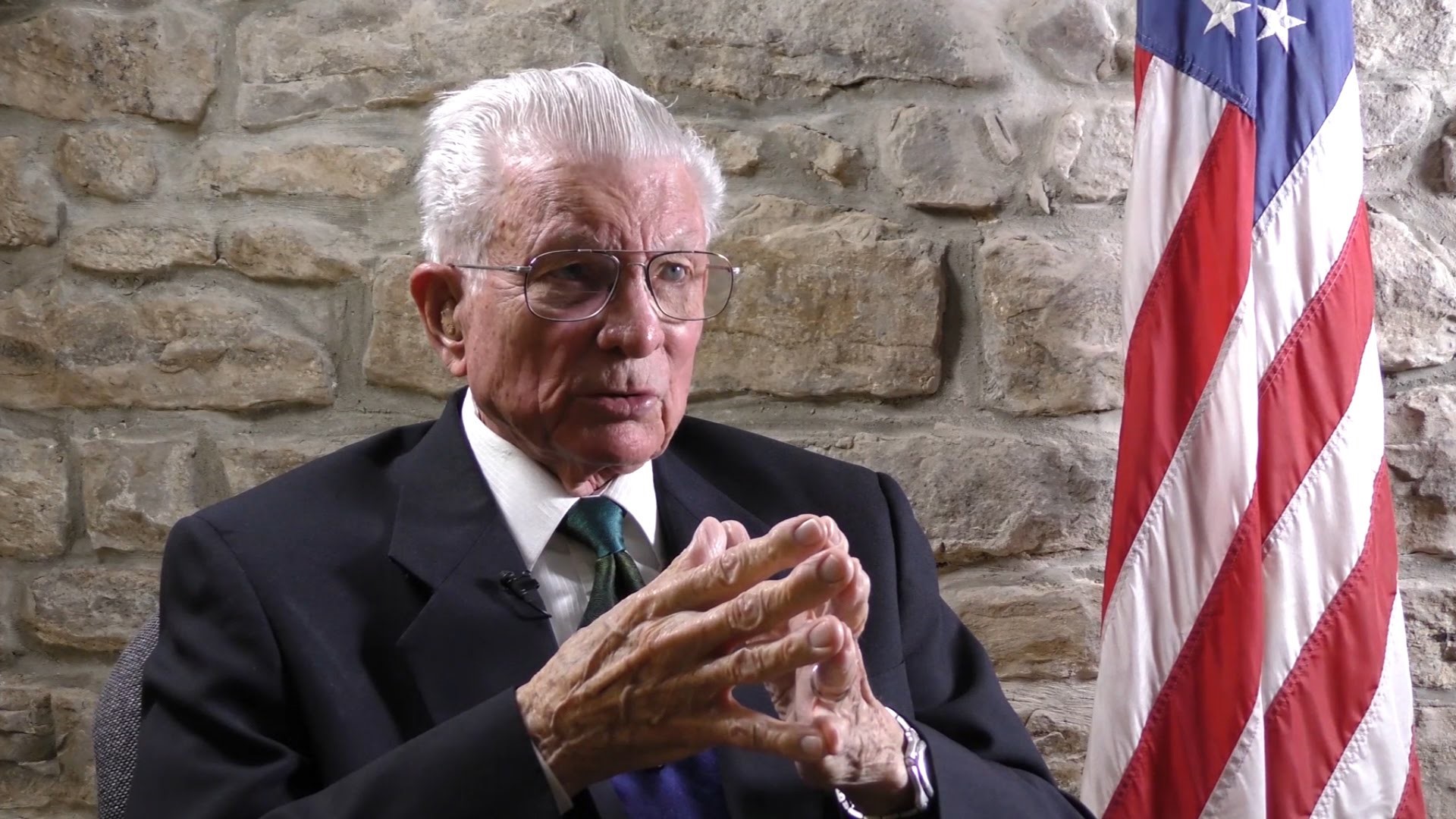
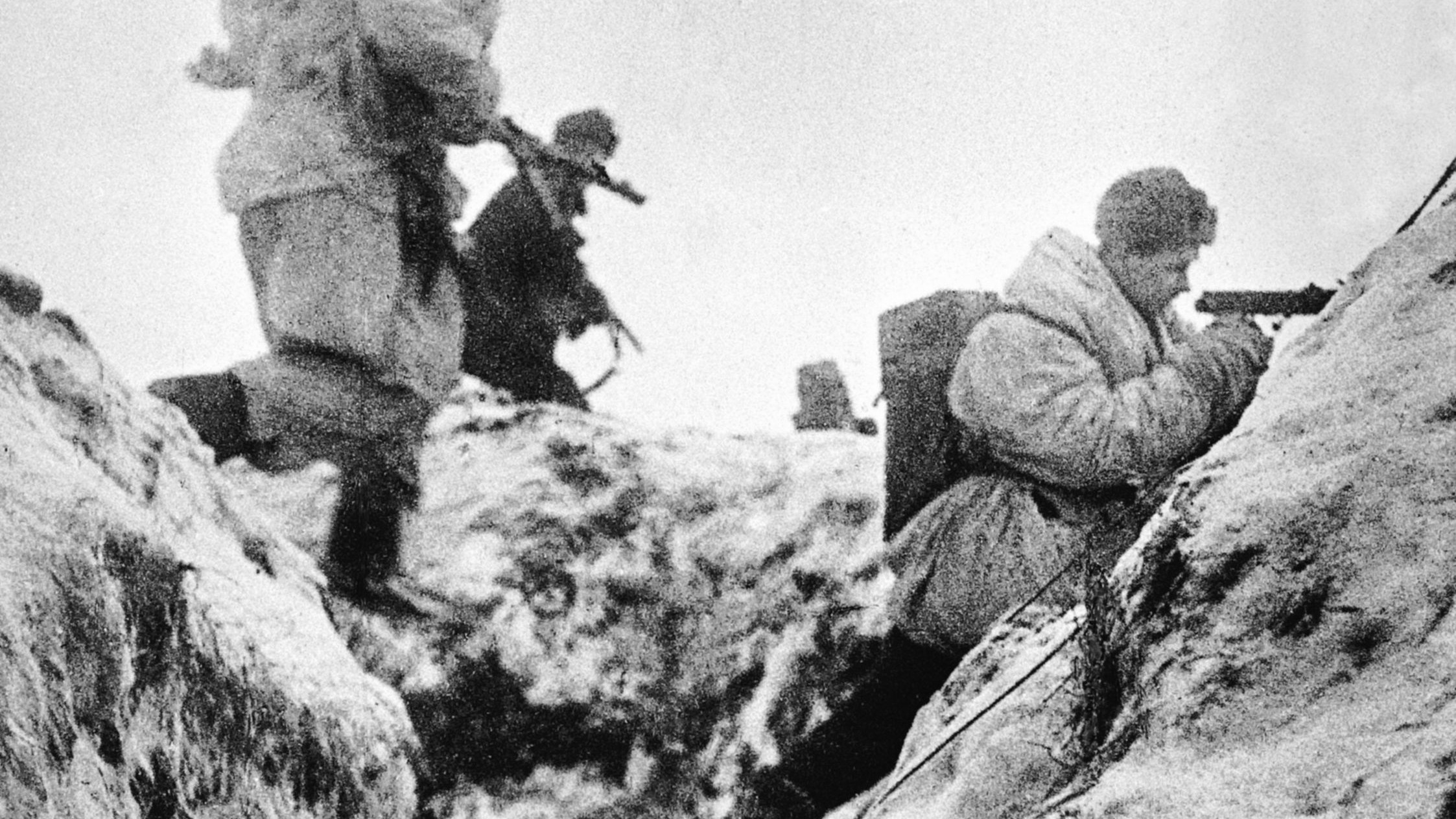
AS USUAL A TERRIFIC ACCOUNT OF GREAT ACTIONS.
YOU ARE NUMBER ONE.
OSCAR LOPEZ
Awesome writing. Even though I know Marine Corps History, these great stories fill in the gray areas.
Semper fi
my father Joe McGovern was an officer and pilot in the Squadron he was the wingman for Lindbergh when he was flying in the Pacific Theater Bill Freeman was his best man in my parents wedding Joe Foss and my father remained friends along with Pappy Boyington and his wife till the end
Hello, I am just now reading your comment. Sorry, I didn’t read it sooner.
I am one of the original crew from the VMF 115 squadron ground crew. I joined the squadron in Santa Barbara. When we left Santa Barbara, we went to San Diego and boarded a Navy ship called the Pocomoke. We got off at Guadalcanal. I stayed with the squadron for two landings in the Philippines-Layte and Mindanao. I came home in 1946 and received my discharge at Miramar Base. I stayed in contact with Senator Salvadore for many years. Louis Cerrone was the last one to pass away from the squadron as far as I know. I was an invited guest at the Miramar Air Station when they renamed the air field for Joe Fosse. Please contact me at 858 245-1716 or my daughter’s email, lesliegranger@rocketmail.com. I’d like to hear from you soon. I am 97 and live in Coronado, California.
Walter Travis, SGT, USMC
I’m so sorry I Did not see this message until today. You can always contact me at my cell phone number 941-993-2147. I have five siblings that are also very interested in the history of Joe Foss and those with him
My Father Larry E Bisset was also a member, I have pictures of him and crew while he was a 1st SGT. Maybe you knew him.
My dad was a crew chief, LCpl Robert T. Blizek, USMC, VMF-115.
My Grandpa, Clyde Brummell, was a member of this unit, part of the support crew. This is a great history; so many of Grandpa’s stories are reflected in here. Thank you for putting this together!
i have a picture of col. lindberg & my dad in the phillipines arm & arm. my dads corsair was tested by lindberg; got a kill doing so
Joe Foss later became governor of South Dakota and an avid hunter. In the 60’s he had a weekly show called the American Sportsman. It was on ABC on Saturday. My Great Uncle was one of his best friends. They would hunt all the time and jointly owned some land in Montana that became Big Sky ski resort.
My dad was an F4U Corsair pilot, Navy not Marine, and flew from a carrier in the Pacific theater. Termed “The Ensign Killer” because it was notoriously difficult to land on a ship, Dad loved the plane and made great use of its high service ceiling. He’d tell me stories about attaching five-gallon cans under his wings, filling them with water, powdered milk, and coco, and flying up to altitude. It was hot in the South Pacific, and after flying around for awhile he’d land back on the carrier to be quickly greeted by the deck crew. They’d immediately detach the six five-gallon cans and distribute the contents to their shipmates. Dad will have just made thirty gallons of chocolate ice cream.
My recently deceased father-in-law was Captain Paul Becker and he proudly piloted a Corsair with Joes Jokers. He spoke highly of Joe Fosse. What a brave group of men to whom we all owe a great deal.
“…an airstrip of Marston mat had been laid over the sand.”
I remember reading about this matting when I was a kid (50+ years ago). I have always marveled at American ingenuity. Need a runway in a hurry, stable enough to permit frequent landing & takeoffs on sandy or loose soil? Bulldoze a strip, and lay matting on top of it — durable, modular, easy to fit together, quick to repair. Voila!
Brilliant.